Publication
Article
Supplements and Featured Publications
Examining Unmet Needs in the Management of Eosinophilic Esophagitis
Author(s):
Abstract
Eosinophilic esophagitis (EoE) is a chronic inflammatory disease driven by a type 2 immune response and characterized by the accumulation of immune cells (eosinophils, basophils, and mast cells) in the esophagus. Patients may present with EoE at any age, and its prevalence is similar across age groups in the United States. If EoE is suspected, an endoscopy with biopsy is required to confirm the diagnosis; endoscopy allows clinicians to evaluate for the presence of rings, furrows, exudates, edemas, and/or strictures and biopsy helps to identify the associated histological changes, including eosinophilic infiltration of the esophageal mucosa. Symptoms of EoE vary by age and include dysphagia, impaction, regurgitation, chest and/or abdominal pain, and vomiting. Allergic comorbidities (eg, allergic rhinitis, asthma, or atopic dermatitis) are common among patients with EoE, which suggests that there may be a shared pathophysiology underlying these conditions. The symptoms of EoE vary widely from patient to patient, and delays in diagnosis are common. Disease progression may lead to lasting damage, including scarring and fibrosis of the esophagus, underscoring the need for early diagnosis and treatment to reduce the clinical, economic, and humanistic burden associated with EoE. Current standard of care treatment options include diet therapy, esophageal dilation, proton pump inhibitors, and topical swallowed corticosteroids; however, these treatments may not provide optimal disease management over the long term. The symptoms of EoE, its complications, and disease management considerations (eg, dietary limitations) are associated with diminished quality of life. There remains an unmet need for long-term management options. It is important for stakeholders to understand the current treatment landscape and unmet needs when considering the assessment of future therapies.
Am J Manag Care. 2021;27(suppl 17):S311-S318. https://doi.org/10.37765/ajmc.2021.88756
Introduction
Eosinophilic esophagitis (EoE) is a progressive, chronic inflammatory disease that is associated with a substantial disease burden and long-term complications.1,2 Early and accurate diagnosis of EoE is critical for preventing worsening, potentially irreversible damage to the esophagus.2 Esophageal remodeling, narrowing, and fibrosis can occur when EoE is inadequately controlled; the duration of untreated disease is the strongest predictor of esophageal stricture.3,4 Despite the availability of treatment options, the clinical needs of patients with EoE remain largely unmet.5
Symptoms of undiagnosed and untreated EoE differ by age and include difficulty swallowing (dysphagia), food getting stuck in the esophagus (impaction), regurgitation, chest and/or abdominal pain, and vomiting.1,6 Additionally, most patients with EoE have comorbid allergic conditions, such as allergic rhinitis, asthma, atopic dermatitis, or food allergies, suggesting a related pathophysiology among these conditions.7,8 Infiltration of the esophagus by eosinophils represents a defining characteristic of EoE, and this persistent inflammation is associated with the formation of esophageal abnormalities such as rings, furrows, strictures, edema, and exudates.1,9 The chronic, progressive nature of EoE contributes to significant patient burden.1
Epidemiology
EoE can develop at any age, and is more common in males and in Whites, and is strongly associated with atopic diseases.10 A 2019 systematic review of 24 studies conducted in various locations (United States, Canada, Europe, Australia, South America) found that the overall prevalence of EoE was 34.2 cases per 100,000 inhabitants (95% CI, 23.1-47.5; I2 = 99.9%), and that disease prevalence has been increasing over time.11 In the United States and Canada, EoE was estimated to occur in 41 (95% CI, 25.7-59.9; I2 = 99.7%) per 100,000 individuals. Although the overall prevalence was found to be higher in adults than children (42.2 [95% CI, 31.1-55; I2 = 99.9%] vs 34.4 [95% CI, 22.3-49.2; I2 = 99.8%]), in the United States and Canada, specifically, the disease was found to impact both groups similarly (31.9 [95% CI, 21.5-44.3; I2 = 100%] vs 38.3 [95% CI, 23.7-6.4]; I2 = 99.9%).11
Pathophysiology
First classified as a unique clinicopathologic syndrome in 1993, much has been learned about EoE over the last approximately 30 years.12 Evidence suggests that EoE is largely driven by a type 2 immune response, characterized by immune dysregulation (elevation of cytokines IL-4, IL-13, and IL-5; eosinophils, basophils, and mast cells; immunoglobulin G4; and epithelial barrier dysfunction.7,13,14 Pathologic processes primarily arise from chronic, uncontrolled type 2 inflammation. In EoE, the TH2-derived cytokines IL-4, IL-13, and IL-5 are responsible for recruiting eosinophils to the esophagus and promoting their maturation and activation (Figure 17,15,16,17).18 This culminates in epithelial barrier dysfunction, tissue remodeling, fibrosis, and smooth muscle hyperplasia.17 As depicted in Figure 2,3 the type 2 inflammation underlying EoE pathophysiology has the potential to significantly remodel the esophagus as the disease progresses.3,14
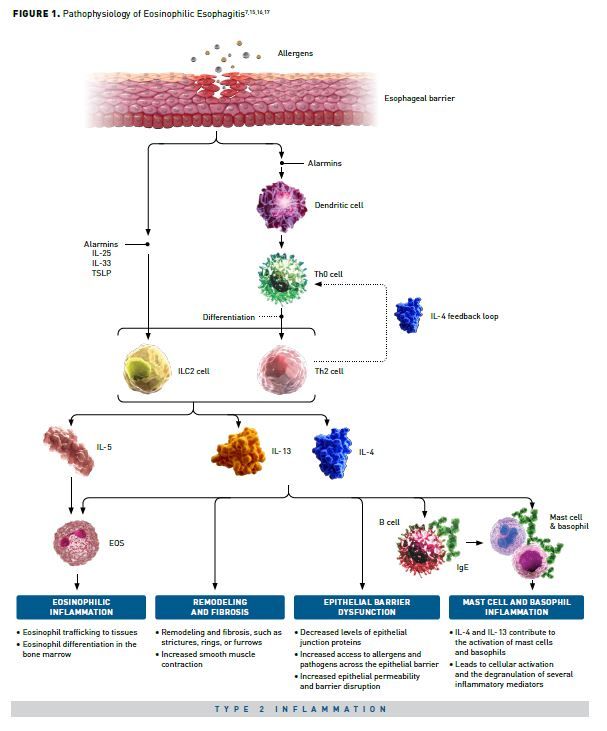
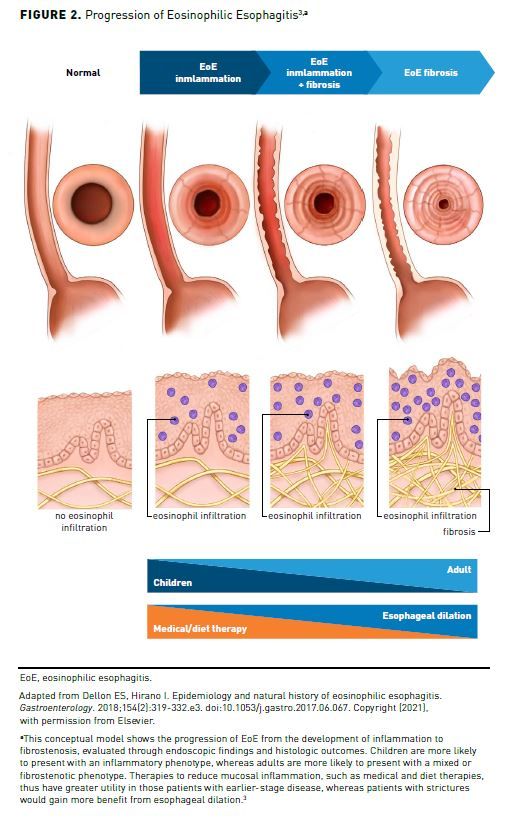
Diagnosis of EoE
The following 3 criteria must be met to diagnose EoE: (1) presence of clinical signs and symptoms suggestive of EoE; (2) esophageal eosinophilia, and (3) exclusion of other disorders that may cause elevated eosinophil level in the esophagus.19
Clinical signs and symptoms of EoE vary by age and duration of disease,3 with infants and young children presenting differently than adolescents and adults (Table).1 When EoE is suspected, an esophagogastroduodenoscopy (EGD) is carried out to assess the esophagus for signs of rings, furrows, exudates, edemas, and/or strictures.19 After diagnosis, this procedure is commonly used for monitoring of disease progression.5
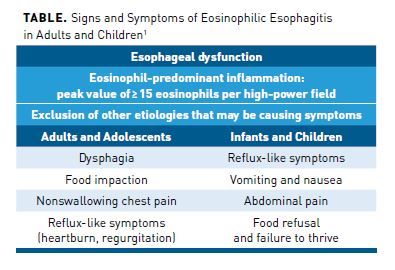
Symptoms of EoE may not correlate with the degree of eosinophilia.20 A histological assessment of an esophageal biopsy must reveal at least 15 eosinophils per high-power field (HPF) for an EoE diagnosis, and eosinophilic infiltration must be isolated to the esophagus.1 Other disorders known to cause esophageal eosinophilia must be ruled out to confirm an EoE diagnosis. These non-EoE diseases include gastroesophageal reflux disease, eosinophilic gastrointestinal disorders, Crohn disease, infection, hyper eosinophilic syndrome, achalasia, drug hypersensitivity, vasculitis, pemphigus, hypermobility syndromes, and graft-versus-host disease.19 In light of the shared pathophysiologic processes and frequent co-occurrence, suspicion of EoE is elevated in patients with other type 2 inflammatory diseases, such as allergic rhinitis, asthma, food allergies, and/or atopic dermatitis.7,19
Because of the heterogenous symptomology and gradual progression of disease severity, diagnostic delays in EoE are common.4,6,21 Investigators on a 2018 study analyzed the clinical, endoscopic, and histopathologic features of over 700 children and adults with EoE across the United States from a multisite registry developed by the Consortium for Food Allergy Research.6 EoE was diagnosed in these patients based on histology (≥ 15 eosinophils/HPF) and symptoms of esophageal dysfunction. A total of 705 patients were analyzed in the study; they were predominantly male (68.2%) and White (87.9%), with a median age of 11.2 years (interquartile range [IQR]: 6.7-17.7 years). The median patient age at the time of EoE diagnosis was 8 years. The median diagnostic delay was 1.5 years in the patient population overall; however, longer delays were reported in older patients. The median time from symptom onset to diagnosis was 4.0 years in adults, 2.0 years in 11- to 17-year-old patients, and 1.0 year in children less than 11 years of age. Study results also indicated that a history of food allergy or atopic dermatitis was associated with a significantly shorter delay in the diagnosis of EoE, with the median time from symptom onset to diagnosis being 1.1 years (IQR: 0.5-3.5; P < .05) and 1 year (IQR: 0.5-3.0; P < .05), respectively.6
The results of another study found that patients with longer diagnostic delays were more likely to have both fibrotic (strictures) and inflammatory features of EoE. This retrospective analysis of the Swiss EoE database, which included 783 EoE patients in total, found that 200 had complete clinical, endoscopic, histologic, and laboratory data. Among these 200 patients, the prevalence of strictures at EoE diagnosis was significantly correlated with the duration of diagnostic delay. Strictures occurred in a total of 17.2% of patients (n = 58) with a 0- to 2-year diagnostic delay compared with 70.8% of patients (n = 24) with a more than 20-year diagnostic delay (P < .001). Age at onset of EoE was not associated with the presence of strictures at EoE diagnosis.4
Currently Available Treatments
The current standard of care for patients with EoE consists of dietary therapies, esophageal dilation, and medication. Dietary therapies for EoE include an allergy testing–based elimination, empiric elimination, and an elemental diet. With the goal of mechanically widening the esophagus, esophageal dilation is an endoscopic treatment for EoE that involves bougies or balloons. Standard of care drugs include proton pump inhibitors (PPIs) and topical swallowed corticosteroids.5,22
Diet
There are 3 general diet-modification approaches used to manage patients with EoE: an elemental diet, an elimination diet guided by food allergy testing, and an empiric elimination diet.5 All of these are contingent upon the role dietary antigens appear to play in EoE pathophysiology. Two of the 3 dietary therapies (the food allergy-based elimination diet and the empiric elimination diet) include the elimination of foods that may be exacerbating EoE. The allergy-based elimination diet utilizes allergy-based skin prick and patch testing to determine which foods a patient may be allergic to, whereas the empiric elimination diet removes foods that are most commonly associated with allergic responses.13 The 2020 guidelines from the American Gastroenterological Association (AGA) and Joint Task Force on Allergy-Immunology Practice Parameters (JTF) recommend all 3 dietary therapies over no treatment, but note that the evidence for these recommendations is of low to moderate quality, and that the inherent challenges of the different diets may not be preferred by all patients.5
Dilation
Esophageal remodeling as a result of persistent inflammation may lead to fibrosis, and esophageal narrowing and strictures, resulting in dysphagia and impaction.1,10 Results from a systematic review and meta-analysis of 27 studies determined that 95% (95% CI, 90%-98%) of patients with EoE who undergo esophageal dilation (n = 845) report symptom improvement13,23; however, the procedure is associated with risks and multiple dilations may be necessary for symptom control.24 The potential complications of the dilation procedure include small mucosal tears, chest pain, deep mucosal tears, and esophageal perforation.23,24 The AGA/JTF 2020 guidelines recommend dilation over no dilation in adults with stricture-induced dysphagia, and AGA/JTF note that the evidence supporting this intervention is of very low quality and comment that the procedure does not address the esophageal inflammation associated with EoE.5
Medications
PPIs and corticosteroids to manage EoE are recommended over no treatment at all in the AGA/JTF 2020 guidelines, with topical swallowed corticosteroids recommended over oral corticosteroids.5
PPIs
No FDA-approved dosage guidelines exist for PPI therapy in EoE, thus treatment is primarily guided by symptomatic and histological responses in patients.22,25 Following a trial period, those who do not respond can discontinue PPI therapy, whereas those who achieve a partial response can add a topical swallowed corticosteroid or dietary modification to PPI therapy.22 Patients who achieve complete endoscopic normalization may try a lower PPI dose to establish a minimum maintenance dose,22 as long-term treatment with PPIs might rarely be associated with increased risk of gastrointestinal infections, pneumonia, kidney impairment, fracture risk, and gastric tumors.26-28
Overall response to therapy with PPIs is mixed. The results of a 2016 systematic review and meta-analysis of 33 studies reported clinical remission of EoE in 60.8% (95% CI, 48.4%-72.2%; I2 = 80.2%) of patients treated with PPIs, and histological remission in 50.5% (95% CI, 42.2%-58.7%; I2 = 67.5%).29 Based on these results, the 2020 AGA/JTF guidelines state that PPI therapy is recommended in patients with symptomatic EoE over no treatment; however, the guidelines note that the evidence for this recommendation is of very low quality.5
Topical Swallowed Corticosteroids
Topical formulations of corticosteroids are used to coat the esophagus and provide broad anti-inflammatory effects.30 Although there are no FDA-approved medications for EoE, the topical corticosteroids budesonide and fluticasone are commonly used off-label in the United States in patients with EoE who fail to respond to PPIs.30 Budesonide is aqueous and patients are instructed to mix the liquid with a sugar substitute and swallow it.30,31 Fluticasone is aerosolized and packaged in a multidose inhaler; patients are instructed to puff the medication into their mouths and swallow it.30,32
The use of topical swallowed corticosteroids is strongly recommended by the AGA/JTF over no treatment, and in patients who achieve histologic remission following short-term use of topical swallowed corticosteroids, continuation of treatment is recommended over cessation. The guidelines do note that longer-term safety data in children are needed, particularly in relation to adrenal function and growth suppression.5
Topical swallowed corticosteroids produce clinical and histologic remission, as well as endoscopic normalization; however, cessation of therapy often results in relapse.33,34 The results of 1 observational single-center study found that among 351 patients with EoE, 78.8% relapsed following cessation of treatment (median time to relapse following treatment was 22.4 weeks).34 Accordingly, patients with EoE who achieve histologic remission with topical swallowed corticosteroids may consider maintenance therapy rather than cessation.1 Some adverse events (AEs) associated with topical swallowed corticosteroid use include esophageal and oral candidiasis, sore throat, chest pain, pneumonia, and food impaction.30 Additionally, systemic absorption of topical swallowed corticosteroids in children with EoE may be associated with adrenal axis sup pression.35
The use of systemic corticosteroids is not recommended in EoE. Although their efficacy is generally comparable to that of topical swallowed corticosteroids, their chronic use is known to be associated with a range of AEs (eg, hyperphagia, weight gain, Cushingoid features, growth suppression in children, and osteoporosis).1,36
Treatment Considerations
Response to EoE treatment is categorized into 3 general groups (nonresponse, response, and complete endoscopic normalization) based on clinical and histological outcomes. Patients classified as having a nonresponse maintain persistent eosinophilia with at least 15 eosinophils per HPF, persistent symptoms with a less than 30% decrease in a symptom metric, and persistent endoscopic findings with a less than 30% decrease in endoscopic reference score. Responders achieve reduced eosinophilia (higher than normal level of eosinophils in the blood) and a decrease in symptoms with a 30% to 90% decrease in a symptom metric, along with improved endoscopic findings. Patients who achieve complete endoscopic normalization have less than 1 eosinophil per HPF, symptom resolution with a greater than 90% decrease in a symptom metric, and normal endoscopic findings with an endoscopic reference score of less than 2.37
Despite the current therapies, long-term management of EoE can be challenging and initial treatment failure and/or disease reoccurrence is common.38,39 In a retrospective cohort study of 100 patients with confirmed EoE, 67% of those who chose initial dietary therapy (n = 54/81) achieved histologic remission compared with 56% of those who chose initial pharmacological therapy (n = 9/16).39 Of the 34 patients who failed to achieve a response to initial therapy, 24 elected to undergo rescue therapy with an elimination diet or food allergy-based elimination diet, or topical swallowed corticosteroids. Eleven of these patients still failed rescue therapy.39
Patients who responded to initial therapy had significantly more symptoms (heartburn, dysphagia, vomiting [P < .005]; feeding dysfunction, abdominal pain [P < .05]) and endoscopic findings (furrows [P < .005]; edema and rings [P < .05]) than those who did not. Conversely, those who did not respond to initial treatment were shown to have higher peak eosinophil counts per HPF in the proximal and mid esophagus than those who did respond (28 vs 20, P < .005; 30 vs 20, P < .005, respectively). No statistical differences between symptoms, endoscopic findings, and peak eosinophil counts per HPF were found between those patients who responded to rescue treatments and those who did not.39
Optimizing treatment for patients with EoE depends on the severity of their disease, and lifestyle and preferences.22 Therapy can be combined to improve or expedite remission (ie, a patient with severe symptomatic esophageal strictures could initiate treatment with the combination of a topical swallowed corticosteroid, food elimination diet, and esophageal dilation, to achieve clinical and histologic remission, and endoscopic normalization).22 Further investigation into the natural history of EoE in both children and adults is needed to optimize its management.5
Burden of Disease
The long-term complications associated with EoE include: (1) persistent inflammation; (2) esophageal tissue remodeling and potential for fibrosis; (3) increased esophageal constriction; and (4) progressive disease severity.1,34,40 Relapse and recurrence of EoE symptoms occur as a result of diminishing efficacy of long-term treatments or discontinuation of therapy.5,38,41 Complications and disease management can negatively impact the quality of life (QOL) of patients with EoE.42 Patients of all ages face challenges related to social isolation due to dining restrictions, the potential need for a gastrostomy tube, costs of elemental formula, and difficulties related to undergoing repeated endoscopies requiring sedation and biopsy.5
Clinical Burden
Patients with EoE report substantial clinical burden,43 and experience impaired QOL because of the progressive nature of the disease and the impact on daily life.1,43 Adults with EoE may have restrictive symptoms, including dysphagia and food impaction, which impairs their ability to eat, whereas children with EoE commonly refuse food and can fail to thrive.1,44 Additionally, patients with EoE may need repeat endoscopies, and those with more advanced disease may require rescue therapies, including endoscopic dilation, at the emergency department for symptomatic relief.45,46
Concomitant type 2 inflammatory conditions, such as allergic disorders, also are common in patients with EoE and can increase disease burden. Allergic disorders were reported in over 90% of patients in a multisite single-visit registry of patients with EoE in the United States. Of the 705 patients (age range: 0.9-56.2 years) enrolled between May 2011 and March 2016, the most common allergic disorder was food allergy (67.0%), followed by allergic rhinitis (60.3%), atopic dermatitis (46.4%), asthma (45.4%), allergic conjunctivitis (31.2%), urticaria (26.2%), food anaphylaxis (27.1%), and angioedema (13.2%) (Figure 3).6
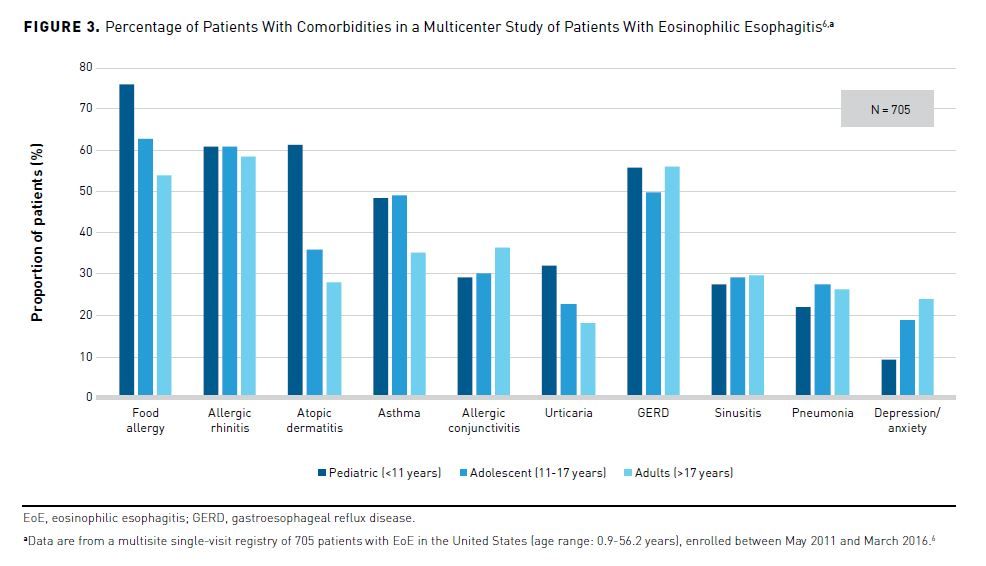
Similarly, the results of a longitudinal study of electronic medical record (EMR) data from 130,435 patients in the Children’s Hospital of Philadelphia medical network found that prior diagnosis of a type 2 inflammatory disease increased the risk of EoE diagnosis. The investigators reviewed birth cohort data from January 1, 2001, to December 31, 2017, and found that of the 139 children who developed EoE, the presence of atopic dermatitis, IgE-mediated food allergy, and asthma all were independently and cumulatively associated with a subsequent diagnosis of EoE: atopic dermatitis (HR 3.2, 95% CI 2.2-4.6), IgE-mediated food allergy (HR 9.1, 95% CI 6.5-12.6), and asthma (HR 1.9, 95% CI 1.3-2.7).47
Economic Burden
According to a matched, case-control analysis of commercial medical and pharmaceutical insurance claims data from 2009 and 2010, the estimated total annual health care costs for EoE are more than $500 million (based on a prevalence of 56.7 cases per 100,000 individuals [age range: 0-64 years]), and up to $1.3 billion (based on a prevalence of 153.2 cases per 100,000 individuals).45 Taking inflation into account, this amount translates to approximately $665 million to $1.73 billion in 2020 (based on an estimated inflation rate of about 33%, determined by the Consumer Price Index for Medical Costs48 and dollars alone, without regard to other influences, such as new treatments). These figures reflect the costly diagnosis and management strategies for EoE, such as multiple upper endoscopies with biopsies (Figure 4).45,48 For example, during the 2-year period, patients with EoE (n = 8135) had significantly more claims for upper endoscopies than those without EoE (n = 32,540) (2 claims vs 0.1 claims; P < .001; age range for all patients: 0-64 years).45
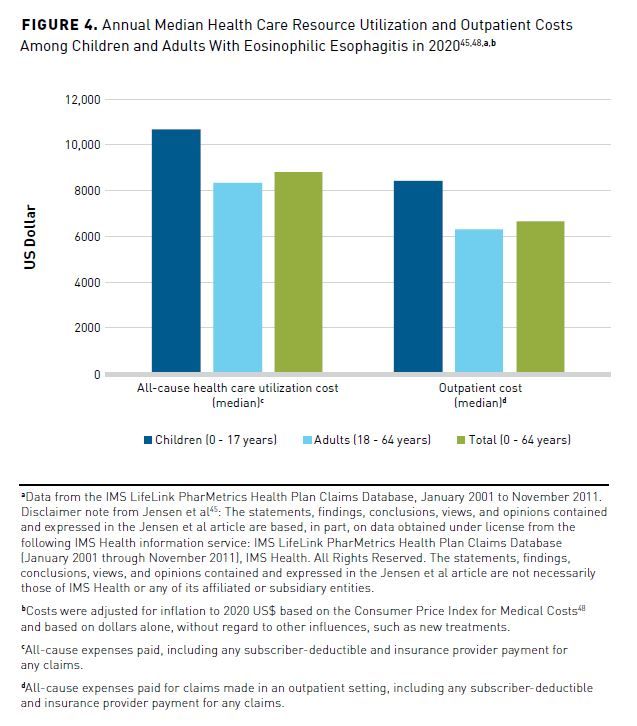
Humanistic Burden
The impact of EoE on health-related QOL has been shown to increase with disease severity.2 For example, in a study conducted between March 2013 and May 2014, patients with EoE for at least 17 years who needed an endoscopy for diagnosis, further confirmation of a suspected diagnosis, or monitoring of previously diagnosed EoE were invited to recall their QOL and symptom severity over the last 7 days using validated instruments.43 Results indicated that the presence of dysphagia was correlated with decreased QOL and increased disability.
Similarly, the results of a 2011 qualitative study of patient-reported outcomes in 24 adults with EoE found that they were most worried about the impact of EoE on their ability to eat (87% of patients), concerns regarding dysphagia (67%), and the impact of EoE on their social relationships (65%). About half of the patients (49%) were worried about available treatments.49
More recently, the results of a 2019 cross-sectional, internet-based survey of adult patients with EoE (n = 243) and adult caregivers of pediatric patients with EoE (n = 270) showed that more than 42% reported low shared decision-making in regard to their EoE treatments and only 38% felt content with their current treatment.50
Conclusions
Early diagnosis and effective treatment of EoE is essential for reducing the clinical, economic, and humanistic impact of this disease. Current treatment options (diet therapy, esophageal dilation, PPIs, and topical swallowed corticosteroids) do not specifically target type 2 inflammation in EoE. As the prevalence of EoE continues to increase, it is imperative to understand existing unmet needs to optimize all aspects of its management, including long-term care.
Authorship affiliation: Carolina Asthma & Allergy Center, Charlotte, NC.
Funding source: This work is supported by Sanofi and Regeneron Pharmaceuticals, Inc.
Author disclosure: Dr Johnston has the following relevant financial relationships with commercial interests to disclose: he has a board membership with the Medical Advisory Board for APFED; he has been a consultant for Takeda for HAE; and he has received lecture fees for speaking at the invitation of Takeda.
Authorship information: Concept and design; drafting of the manuscript; critical revision of the manuscript for important intellectual content; supervision.
Address correspondence to: Douglas T. Johnston, DO, FAAAAI, FACAAI, 2600 East 7th Street Charlotte, NC 28204. Email: DJohnston@CarolinaAsthma.com
References
- Lucendo AJ, Molina-Infante J, Arias Á, et al. Guidelines on eosinophilic esophagitis: evidence-based statements and recommendations for diagnosis and management in children and adults. United European Gastroenterol J. 2017;5(3):335-358. doi:10.1177/2050640616689525
- Muir AB, Brown-Whitehorn T, Godwin B, Cianferoni A. Eosinophilic esophagitis: early diagnosis is the key. Clin Exp Gastroenterol. 2019;12:391-399. doi:10.2147/CEG.S175061
- Dellon ES, Hirano I. Epidemiology and natural history of eosinophilic esophagitis. Gastroenterology. 2018;154(2):319-332.e3. doi:10.1053/j.gastro.2017.06.067
- Schoepfer AM, Safroneeva E, Bussmann C, et al. Delay in diagnosis of eosinophilic esophagitis increases risk for stricture formation in a time-dependent manner. Gastroenterology. 2013;145(6):1230-1236.e1-2. doi:10.1053/j.gastro.2013.08.015
- Hirano I, Chan ES, Rank MA, et al; AGA Institute Clinical Guidelines Committee; Joint Task Force on Allergy-Immunology Practice Parameters. AGA Institute and the Joint Task Force on Allergy-Immunology Practice Parameters clinical guidelines for the management of eosinophilic esophagitis. Gastroenterology. 2020;158(6):1776-1786. doi:10.1053/j.gastro.2020.02.038
- Chehade M, Jones SM, Pesek RD, et al. Phenotypic characterization of eosinophilic esophagitis in
a large multicenter patient population from the Consortium for Food Allergy Research. J Allergy Clin Immunol Pract. 2018;6(5):1534-1544.e5. doi:10.1016/j.jaip.2018.05.038 - Hill DA, Spergel JM. The immunologic mechanisms of eosinophilic esophagitis. Curr Allergy Asthma Rep. 2016;16(2):9. doi:10.1007/s11882-015-0592-3
- Hill DA, Dudley JW, Spergel JM. The prevalence of eosinophilic esophagitis in pediatric patients with IgE-mediated food allergy. J Allergy Clin Immunol Pract. 2017;5(2):369-375. doi:10.1016/j.jaip.2016.11.020
- Hirano I, Moy N, Heckman MG, Thomas CS, Gonsalves N, Achem SR. Endoscopic assessment of the oesophageal features of eosinophilic oesophagitis: validation of a novel classification and grading system. Gut. 2013;62(4):489-495. doi:10.1136/gutjnl-2011-301817
- Dellon ES, Liacouras CA. Advances in clinical management of eosinophilic esophagitis. Gastroenterology. 2014;147(6):1238-1254. doi:10.1053/j.gastro.2014.07.055
- Navarro P, Arias Á, Arias-González L, Laserna-Mendieta EJ, Ruiz-Ponce M, Lucendo AJ. Systematic review with meta-analysis: the growing incidence and prevalence of eosinophilic oesophagitis in children and adults in population-based studies. Aliment Pharmacol Ther. 2019;49(9):1116-1125.doi:10.1111/apt.15231
- Spechler SJ. Eosinophilic esophagitis: novel concepts regarding pathogenesis and clinical manifestations. J Gastroenterol. 2019;54(10):837-844. doi:10.1007/s00535-019-01604-7
- Gómez-Aldana A, Jaramillo-Santos M, Delgado A, Jaramillo C, Lúquez-Mindiola A. Eosinophilic esophagitis: current concepts in diagnosis and treatment. World J Gastroenterol. 2019;25(32):4598-4613. doi:10.3748/wjg.v25.i32.4598
- O’Shea KM, Aceves SS, Dellon ES, et al. Pathophysiology of eosinophilic esophagitis.
Gastroenterology. 2018;154(2):333-345. doi:10.1053/j.gastro.2017.06.065 - Gandhi NA, Bennett BL, Graham NMH, Pirozzi G, Stahl N, Yancopoulos GD. Targeting key proximal drivers of type 2 inflammation in disease. Nat Rev Drug Discov. 2016;15(1):35-50. doi:10.1038/nrd4624
- Davis BP, Rothenberg ME. Mechanisms of disease of eosinophilic esophagitis. Annu Rev Pathol. 2016;11:365-393. doi:10.1146/annurev-pathol-012615-044241
- D’Alessandro A, Esposito D, Pesce M, Cuomo R, De Palma GD, Sarnelli G. Eosinophilic esophagitis: from pathophysiology to treatment. World J Gastrointest Pathophysiol. 2015;6(4):150-158.doi:10.4291/wjgp.v6.i4.150
- Molina-Infante J, Lucendo AJ. Update on topical steroid therapy for eosinophilic esophagitis. Gastroenterol Hepatol. 2015;38(6):388-397. doi:10.1016/j.gastrohep.2014.12.006
- Dellon ES, Liacouras CA, Molina-Infante J, et al. Updated international consensus diagnostic criteria for eosinophilic esophagitis: proceedings of the AGREE Conference. Gastroenterology. 2018;155(4):1022-1033.e10. doi:10.1053/j.gastro.2018.07.009
- Friedlander JA, DeBoer EM, Soden JS, et al. Unsedated transnasal esophagoscopy for monitoring therapy in pediatric eosinophilic esophagitis. Gastrointest Endosc. 2016;83(2):299-306.e1. doi:10.1016/j.gie.2015.05.044
- Lipka S, Kumar A, Richter JE. Impact of diagnostic delay and other risk factors on eosinophilic esophagitis phenotype and esophageal diameter. J Clin Gastroenterol. 2016;50(2):134-140.
doi:10.1097/MCG.0000000000000297 - Hirano I. How to approach a patient with eosinophilic esophagitis. Gastroenterology. 2018;155(3):601-606. doi:10.1053/j.gastro.2018.08.001
- Moawad FJ, Molina-Infante J, Lucendo AJ, Cantrell SE, Tmanova L, Douglas KM. Systematic review with meta-analysis: endoscopic dilation is highly effective and safe in children and adults with eosino-philic oesophagitis. Aliment Pharmacol Ther. 2017;46(2):96-105. doi:10.1111/apt.14123
- Moole H, Jacob K, Duvvuri A, et al. Role of endoscopic esophageal dilation in managing eosin-ophilic esophagitis: a systematic review and meta-analysis. Medicine (Baltimore). 2017;96(14):e5877. doi:10.1097/MD.0000000000005877
- Steinbach EC, Hernandez M, Dellon ES. Eosinophilic esophagitis and the eosinophilic gastrointestinal diseases: approach to diagnosis and management. J Allergy Clin Immunol Pract. 2018;6(5):1483-1495. doi:10.1016/j.jaip.2018.06.012
- Kinoshita Y, Ishimura N, Ishihara S. Advantages and disadvantages of long-term proton pump inhibitor use. J Neurogastroenterol Motil. 2018;24(2):182-196. doi:10.5056/jnm18001
- Lazarus B, Chen Y, Wilson FP, et al. Proton pump inhibitor use and the risk of chronic kidney disease. JAMA Intern Med. 2016;176(2):238-246. doi:10.1001/jamainternmed.2015.7193
- Zhou B, Huang Y, Li H, Sun W, Liu J. Proton-pump inhibitors and risk of fractures: an update meta-analysis. Osteoporos Int. 2016;27(1):339-347. doi:10.1007/s00198-015-3365-x
- Lucendo AJ, Arias Á, Molina-Infante J. Efficacy of proton pump inhibitor drugs for inducing clinical and histologic remission in patients with symptomatic esophageal eosinophilia: a systematic review and meta-analysis. Clin Gastroenterol Hepatol. 2016;14(1):13-22.e1. doi:10.1016/j.cgh.2015.07.041
- Dellon ES, Woosley JT, Arrington A, et al. Efficacy of budesonide vs fluticasone for initial treatment of eosinophilic esophagitis in a randomized controlled trial. Gastroenterology. 2019;157(1):65-73.e5. doi:10.1053/j.gastro.2019.03.014
- Dohil R, Newbury R, Fox L, Bastian J, Aceves S. Oral viscous budesonide is effective in children with eosinophilic esophagitis in a randomized, placebo-controlled trial. Gastroenterology. 2010;139(2):418-429. doi:10.1053/j.gastro.2010.05.001
- Teitelbaum JE, Fox VL, Twarog FJ, et al. Eosinophilic esophagitis in children: immunopathological analysis and response to fluticasone propionate. Gastroenterology. 2002;122(5):1216-1225. doi:10.1053/gast.2002.32998
- Greuter T, Safroneeva E, Bussmann C, et al. Maintenance treatment of eosinophilic esophagitis with swallowed topical steroids alters disease course over a 5-year follow-up period in adult patients. Clin Gastroenterol Hepatol. 2019;17(3):419-428.e6. doi:10.1016/j.cgh.2018.05.045
- Greuter T, Bussmann C, Safroneeva E, et al. Long-term treatment of eosinophilic esophagitis with swallowed topical corticosteroids: development and evaluation of a therapeutic concept.
Am J Gastroenterol. 2017;112(10):1527-1535. doi:10.1038/ajg.2017.202 - Ahmet A, Benchimol EI, Goldbloom EB, Barkey JL. Adrenal suppression in children treated with swallowed fluticasone and oral viscous budesonide for eosinophilic esophagitis. Allergy Asthma Clin Immunol. 2016;12:49. doi:10.1186/s13223-016-0154-9
- 3Liu D, Ahmet A, Ward L, et al. A practical guide to the monitoring and management of the complications of systemic corticosteroid therapy. Allergy Asthma Clin Immunol. 2013;9(1):30.
doi:10.1186/1710-1492-9-30 - Dellon ES, Gupta SK. A conceptual approach to understanding treatment response in eosinophilic esophagitis. Clin Gastroenterol Hepatol. 2019;17(11):2149-2160. doi:10.1016/j.cgh.2019.01.030
- Dellon ES, Woosley JT, Arrington A, et al. Rapid recurrence of eosinophilic esophagitis activity after successful treatment in the observation phase of a randomized, double-blind, double-dummy trial. Clin Gastroenterol Hepatol. 2020;18(7):1483-1492.e2. doi:10.1016/j.cgh.2019.08.050
- Leung J, Mehrzad R, Hundal NV, et al. Longitudinal perspective on managing refractory eosin-ophilic esophagitis. J Allergy Clin Immunol Pract. 2015;3(6):951-956. doi:10.1016/j.jaip.2015.06.024
- Dellon ES. No maintenance, no gain in long-term treatment of eosinophilic esophagitis. Clin Gastroenterol Hepatol. 2019;17(3):397-399. doi:10.1016/j.cgh.2018.07.038
- Eluri S, Runge TM, Hansen J, et al. Diminishing effectiveness of long-term maintenance topical steroid therapy in PPI non-responsive eosinophilic esophagitis. Clin Transl Gastroenterol. 2017;8(6):e97. doi:10.1038/ctg.2017.27
- DeBrosse CW, Franciosi JP, King EC, et al. Long-term outcomes in pediatric-onset esophageal eosinophilia. J Allergy Clin Immunol. 2011;128(1):132-138. doi:10.1016/j.jaci.2011.05.006
- Safroneeva E, Coslovsky M, Kuehni CE, et al. Eosinophilic oesophagitis: relationship of quality of life with clinical, endoscopic and histological activity. Aliment Pharmacol Ther. 2015;42(8):1000-1010. doi:10.1111/apt.13370
- Dellon ES, Gibbs WB, Fritchie KJ, et al. Clinical, endoscopic, and histologic findings distin-
guish eosinophilic esophagitis from gastroesophageal reflux disease. Clin Gastroenterol Hepatol.
2009;7(12):1305-1311. doi:10.1016/j.cgh.2009.08.030 - Jensen ET, Kappelman MD, Martin CF, Dellon ES. Health-care utilization, costs, and the burden of disease related to eosinophilic esophagitis in the United States. Am J Gastroenterol. 2015;110(5):626-632. doi:10.1038/ajg.2014.316
- Gluckman C, Falk GW, Muir AB, Benitez A, Lynch KL. The endoscopic burden of eosinophilic esophagitis over a 10-year period. Gastroenterology. 2019;156(6):S-729. Abstract presented at: American Gastroenterology Association Institute Digestive Disease Week; May 2019; San Diego, CA.
- Hill DA, Grundmeier RW, Ramos M, Spergel JM. Eosinophilic esophagitis is a late manifestation of the allergic march. J Allergy Clin Immunol Pract. 2018;6(5):1528-1533. doi:10.1016/j.jaip.2018.05.010
- Consumer Price Index (CPI) for Medical Care. Health Resources & Services Administration. Accessed June 15, 2021. https://www.hrsa.gov/get-health-care/affordable/hill-burton/cpi.html
- Taft TH, Kern E, Keefer L, Burstein D, Hirano I. Qualitative assessment of patient-reported outcomes in adults with eosinophilic esophagitis. J Clin Gastroenterol. 2011;45(9):769-774.
doi:10.1097/MCG.0b013e3182166a5a - Chang JW, Rubenstein JH, Mellinger JL, et al. Motivations, barriers, and outcomes of patient-reported shared decision making in eosinophilic esophagitis. Dig Dis Sci. 2021;66(6):1808-1817. doi:10.1007/s10620-020-06438-5